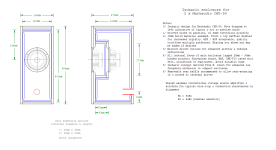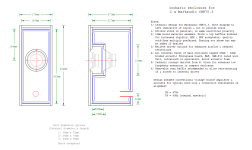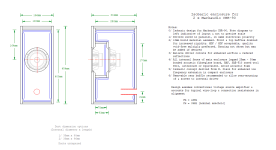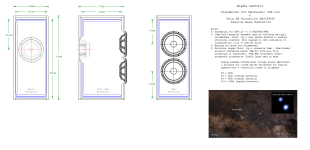Oh yes, I've already done three. Will add later.
None as such, the main benefit of isobaric loading (at least of this kind) is a reduction in box size for a given tuning, so if a driver is suitable for sealed or vented loading, then purely in T/S terms terms it's suitable for isobaric loading, providing it all fits of course. 😉 Bit more to it than that in design terms, but as far as the alignment mathematics goes, it doesn't strictly require anything special.
None as such, the main benefit of isobaric loading (at least of this kind) is a reduction in box size for a given tuning, so if a driver is suitable for sealed or vented loading, then purely in T/S terms terms it's suitable for isobaric loading, providing it all fits of course. 😉 Bit more to it than that in design terms, but as far as the alignment mathematics goes, it doesn't strictly require anything special.
Last edited:
Well, took an extra day as I had to go up to Scarborough yesterday to see an old friend / student in a production of The 39 Steps.
A couple of general notes as these are semi experimental:
A couple of general notes as these are semi experimental:
- The dimensions should be fine, & I've checked them over, but being human (certain generosity of spirit) I may have made a mistake somewhere.
- With the alloy cone versions, I'd be a touch careful with the old volume knob as isobaric designs can see some additional pressures. Because there's air movement in the sub-chamber and the drivers are in parallel, in theory the pressures should be equal, but in practice there can be some departures depending on sealing, thermal changes etc. so a bit of caution initially is probably a good move.
- For these, I've designed assuming flush mounting for the front driver, and the internal unit is rear-mounted, partly for additional chamber clearance as I don't like the idea of very small chambers, and partly because I've also designed assuming a removable rear baffle, so you can get easy access to that unit. Since the MA drivers are designed for flush or surface mounting, you'll need a gasket to ensure proper sealing. The alternative (there is sufficient clearance -I just like a bit of conservative engineering) is to front or flush-mount the internal unit, and use a removable front baffle instead.
- The curtain of damping material (after Linn) in the loading chamber is recommended to help kill reflections & any unwanted remaining midrange / HF. Adjust, as always, to taste. 😉
Attachments
Isobaric sound like a good idea, but doubling the volume only need to increase the 3dimentions by 26% so with the subchamber that is needed the volume saving is even not that much.
True. Although to use a couple of the above as an example, with a 26% increase, internal height alone goes from 400mm to 504mm & external from 454mm to 558mm for the same construction. So although it doesn't sound like much, the practical differences for some conditions can be quite significant. For e.g., the CHR90 box above isn't all that different in proportions to the speakers I have in my desktop setup. I can't physically accommodate anything larger, so the smaller box for a given alignment does offer some advantages in that sense. And isobarics in theory offer some other potential benefits, such as a small reduction in distortion providing you can avoid asymmetry in the loading (close driver tolerances, some chamber damping). You have to factor the increased cost etc. into the equation, but that's a separate issue -I leave it to others to decide what suits them!
@Scottmoose can you explain what is meant by the Makalu CHP-90 description note: "Designed as low-forced MITL, box longitudinal providing vent dampening. Trades reduced-power handling for acoustical efficiency"
For the former, it's close to being a 'full-sized' / 'real' MLTL with the longitudinal providing more of the load to Fb rather than the vent. There's still some forcing, but less than in shorter types. For the latter, it's an efficient load in that Vb is high relative to Vas, Qt, but the price of gain is that excursion rises a little for a given Fb.
Does this mean Makalu CHP-90 box will yield the highest sensitivity/efficiency out of the CHP-90 driver that CHP-90 driver is capable of producing (with the possible exception being front horn loading) and at the expense of power handling meaning can't play too loud without distortion? Of are there better box plans available to us that would do the same without the power handling restrictions? Frugal Horn XL/CHP-90?For the former, it's close to being a 'full-sized' / 'real' MLTL with the longitudinal providing more of the load to Fb rather than the vent. There's still some forcing, but less than in shorter types. For the latter, it's an efficient load in that Vb is high relative to Vas, Qt, but the price of gain is that excursion rises a little for a given Fb.
A box (other than the front-horn mentioned) will not increase sensitivity/efficiency.
The box only affects the bass.
If you want maximum bass gain you want something like the Woden Megaliths/V-Bombers.
dave
The box only affects the bass.
If you want maximum bass gain you want something like the Woden Megaliths/V-Bombers.
dave
Can you tell me if Woden V-Bomber Valiant designed for 120mm Fostex drive units would be appropriate and work for MA CHP-90?If you want maximum bass gain you want something like the Woden Megaliths/V-Bombers.
Or would CHP-90 require a redesigned variant of Valiant more specific for CHP-90?
what are Silbury's H x W x D measurements?At present of the Woden horns Silbury is the best existing match for the 5in MA drivers.
Back from the pit, after a certain amount of badgering in certain quarters 😉 -a CHR-120 box with passive bass radiators. And before anybody asks 'have I considered...[?]' Yes, I have.
There will be more, here or possibly elsewhere (or possibly not the latter since I know Dave is allergic to PBRs & I've already inundated him with new designs this month).
There will be more, here or possibly elsewhere (or possibly not the latter since I know Dave is allergic to PBRs & I've already inundated him with new designs this month).
Attachments
Last edited:
Scottmoose:
Could you recommend a speaker design easily portable with the most SPL and 'Bass' achievable that you have in your archives I could purchase? For outdoor temporary use in a range war with a lawless neighbor.
Thank You for your time and insight on this forum.
I've built a MoFo I can bi-amp or bridge. Waiting on more boards to build a seperate sub. They are in the MoFo Thread linke below.
https://www.diyaudio.com/community/threads/build-this-mofo.313649/post-7404931
Could you recommend a speaker design easily portable with the most SPL and 'Bass' achievable that you have in your archives I could purchase? For outdoor temporary use in a range war with a lawless neighbor.
Thank You for your time and insight on this forum.
I've built a MoFo I can bi-amp or bridge. Waiting on more boards to build a seperate sub. They are in the MoFo Thread linke below.
https://www.diyaudio.com/community/threads/build-this-mofo.313649/post-7404931
I've already inundated him with new designs this month
Cubes & Lowther and a new Megalith for the CHN-50, A5.2/3. A pile of them.
This thread is Scott’s creative outlet, i am unlikely to get them all drawnfrom the sketch.
dave
Still footling with that 5.3 Megalith too. Methinks it's time to invoke my inner Stanley Hooker...
Meantime, will ponder the outdoor / portable speaker requirement. 😉
Meantime, will ponder the outdoor / portable speaker requirement. 😉
It is an unusual request. It's either match them, as I am, but that does not solve the problem. It has only made them wary. Police, they have no respect for or the very specific county law that addresses this that I have to abide and they don't.Meantime, will ponder the outdoor / portable speaker requirement. 😉
Thanks again Scottmoose.
Charles
So, Harrier, or Merlin, then?Still footling with that 5.3 Megalith too. Methinks it's time to invoke my inner Stanley Hooker...
Meantime, will ponder the outdoor / portable speaker requirement. 😉
And would, “not much of a draftsman, are you Dr Lindgren?” be a nasty paraphrase?
- Home
- Loudspeakers
- Full Range
- Miscellaneous designs - Markaudio, Fostex, TB, Dayton, SEAS etc






